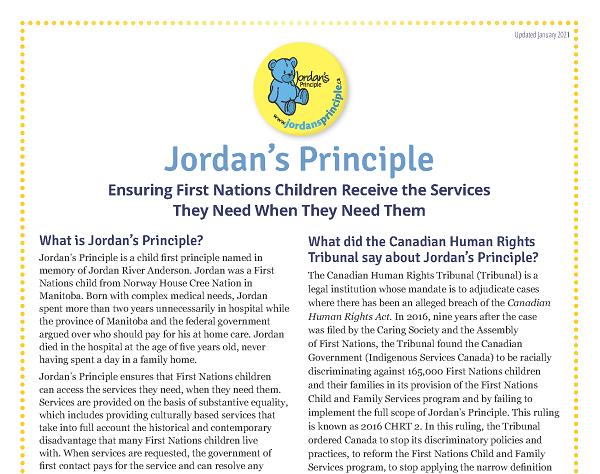Jordan’s Story
“Jordan River Anderson was a First Nations child from Norway Cree House Nation in Manitoba. Born in 1999 with complex medical needs that could not be treated on-reserve, he spent more than two years in a hospital in Winnipeg before doctors agreed that he could leave the hospital to be cared for in a family home. However, because of jurisdictional disputes within and between the federal and provincial governments over who would pay costs for in-home care, Jordan spent over two more years in hospital unnecessarily before he tragically died in 2005. He was 5 years old and had never spent a day in a family home.”
—First Nations Child & Family Caring Society of Canada, August 2014 (Source)
In response to this tragedy, in 2007, the House of Commons unanimously passed Motion-296, enacting Jordan’s Principle. The Principle aims to make sure First Nations children can access all public services in a way that is reflective of their distinct cultural needs. Its focus is on substantive equality and takes full account of the historical disadvantage linked to colonization that First Nations children face. It seeks to ensure that First Nations children do not experience any service denials, delays or disruptions because they are First Nations.
In 2016, the Canadian Human Rights Tribunal concluded “the approach the federal government has taken regarding Jordan’s Principle since Jordan’s Principle was unanimously endorsed by the House of Commons in 2007 was discriminatory, contrary to section 5 of the Canadian Human Rights Act. The Tribunal ordered the federal government to immediately stop applying the discriminatory definition of Jordan’s Principle and to immediately take measures to implement the full definition of Jordan’s Principle.” (Source).
There continue to be frequent misconceptions about Jordan’s Principle and its application. Below we correct four common “myths” about Jordan’s Principle.
MYTH: The Principle applies to cases where there is a dispute over which level of government will pay for a child’s services.
FACT: Jordan’s Principle is about supporting substantive equality for First Nations children when accessing services such as education, mental health, medical equipment, speech therapy and more. According to the Canadian Human Rights Tribunal June 2017 summary of orders, “A jurisdictional dispute between departments or between governments is not a necessary requirement for the application of Jordan’s Principle.”
Jordan’s Principle seeks to ensure that First Nations children can access all public services when they need them, and that those services be culturally based and take into full account the historical disadvantages many First Nations children face. It also seeks to alleviate the administrative burden on children accessing services, and eliminate service denials, delays and disruptions.
MYTH: Jordan’s Principle only applies to First Nations children living on reserve.
FACT: Jordan’s Principle applies equally to all First Nations children both on and off reserve. It is also not limited to only First Nations children with disabilities, or short-term issues. Any First Nation child who requires health or social service or support is eligible.
MYTH: Only a family can apply to have the costs of their child’s services covered under Jordan’s Principle.
FACT: A request for a child or children in the same family or with the same guardian can be submitted by:
- parents or guardians caring for a dependent First Nations child under the age of majority in the child’s province/territory of residence
- a First Nations child above 16 years of age
- an authorized representative of the child, parent or guardian (written or verbal consent must be provided by the parent or guardian)
A community or service provider can make a request on behalf of a group of children from multiple families or guardians.
(Source)
MYTH: Only services required to achieve the same standard of care non-Indigenous children receive will be covered under Jordan’s Principle.
FACT: The Jordan’s Principle fund is not a resource to fund baseline, normative care services for First Nation children. Jordan’s Principle is focused achieving substantive equality, which is not the same as equal treatment. Substantive equality is a human rights concept that weighs factors like discrimination, marginalization, and unequal distribution of resources when considering policies and evaluating outcomes.
According to the Canadian Human Rights Tribunal June 2017 summary of orders regarding Jordan’s principle: “In cases when a government service, including a service assessment, is not necessarily available to all other children, or is beyond the normative standard of care, the government of first contact will still evaluate the needs of the child to determine if the provision of services should be provided to ensure substantive equality, culturally appropriate services, and to safeguard the best interest of the child.”
This means that additional services that are required to achieve substantive equality for a First Nations child must be funded under Jordan’s Principle. The Government of Canada describes it as “…giving extra help when it is needed so First Nation children have an equal chance to thrive.”
To report a Jordan’s Principle case, call the 24-hour line at 1-855-JP-CHILD (1-855-572-4453) or visit www.canada.ca/jordans-principle. If you have any difficulties, please contact the Caring Society at info@fncaringsociety.com or (613) 230-5885.
To learn more about Jordan’s Principle:

